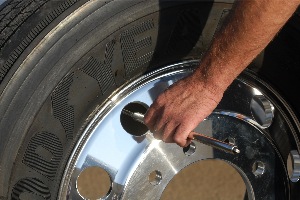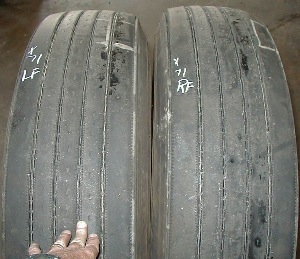Tire responsibility – whose is it anyway? Is it the tire technicians, the truck drivers, the director of maintenance or the tire program manager?
The answer is all of the above. The director of fleet maintenance typically oversees the program. but requires input from the entire team.
It takes a total team approach to have a successful tire program, and with the average price of new tires and retreads continuing to rise at an alarming rate, creating a serious tire program is critical to the fleet bottom line.
It may appear easy to create a successful tire program, but unfortunately it can be a complicated task. The initial step should be meeting with all individuals working directly or indirectly with new tires and retreads. In the very beginning of the process, it’s also important to get your tire distributor and/or brand involved. As you begin the process, many questions need to be asked and testing implemented if you cannot answer them. Some of those questions include:
• Which tire design is best for each of my fleet customer’s wheel positions? You need to help define what is important to the fleet: Is it final removal mileage, is it traction in the wet and snow, is it maximizing retreadability, or is fuel economy the top consideration?
For instance, you can have a drive tire last over 300,000 miles in a long-haul operation. But what if you had a drive tire that lasted 20% fewer miles, or 240,000 original miles, and those same tires increased the fleet’s fuel economy by 2%? At this point you need to get pencil, paper and calculator working on this equation. It may work out that the increase in fuel economy offsets the low mileage by a fairly large percentage, which can easily justify the loss in removal miles.
• How are the tires performing? Getting driver input about tire performance is a key piece of the puzzle. Only the driver can really know if the tire handles well and delivers great traction in a variety of weather and road conditions.
• What about retreading? Retreading is really critical to a successful tire program. A retread is typically one-third the price of a new tire, so it’s very clear why 90% of fleets use them. To maximize retreading there are two keys to success: first is to have a tread depth pull point that is not so low that the casing can easily become damaged by stones and debris. Waiting to remove a tire at the legal limit of 2/32-inch for drive and trailer tires will seriously reduce the retreadability of the tire casing.
At the same time, pulling a tire too soon will cost the fleet in lost removal mileage. A single 32nd of an inch may not sound like much, but over hundreds of tires that sliver of rubber adds up to big dollars.
Secondly, if a high number of casings are rejected for retreading, you’ll need to work with the retreader to analyze the tire casings and determine exactly why. This situation can point to an even more serious tire program problem that will require attention. It could be a mis-application of tire to truck, or perhaps an inflation maintenance issue, or a series of bad tire repairs, or on-road events like curbing or potholes.
Having this knowledge will help you mitigate whatever situation was causing the problem, allowing you to maximize retreadability of more casings in the future.
• How frequently do I need to visually check tires and do pressure checks? More frequent tire inspections will give you an early warning system for a wide range of tire problems, not the least of which include identifying vehicle alignment issues, irregular tire wear, and puncturing objects.
You also should determine the bottom line advantage of keeping the fleet’s tires running at the correct pressure all the time to maximize fuel economy and removal miles and minimize uneven tire wear. Sometimes you need to draw a picture for the equipment or maintenance manager – or the drivers – so they can clearly see the dollar benefit to each psi.
Automating the system certainly doesn’t hurt, either. Running trailers with automatic tire inflation systems will certainly ensure that at least those tires are running at the correct operating pressure all the time.
Tire Pressure Details
Speaking of maintaining proper inflation pressure, have you ever taken apart a stick pressure gauge to analyze why there is variation from gauge to gauge?
Probably not, and most dealers don’t. Many dealers, in fact, may not even realize how much difference there is between gauges.
Truth be told, you may be able to get more accuracy if you purchase and use a pressure gauge that has a dial indicator. Still, even though these gauges are almost always more expensive, their accuracy is not always guaranteed.
Next time you go to purchase a tire pressure gauge with a dial indicator, take a close look at the packaging for information regarding gauge accuracy. A common gauge accuracy is ANSI B40.1 Grade B.
What does that mean? ANSI is the acronym for the American National Standards Institute, a private non-profit organization that oversees the development of voluntary consensus standards for products in the U.S.
B40.1 is the specific standard that has been issued for pressure gauges. Dial pressure gauges have four grades of accuracy: A, B, C, and D (A is the highest).
Dial gauges have two different accuracy ratings based on taking a reading in the middle half of the scale vs. the upper/lower one-quarter of the scale. If a dial gauge has a range of 0 to 160 (common for truck tire gauges), the middle half of the scale would be readings from 40 to 120 psi.
In the middle of the gauge, Grade A has the best accuracy of +/-1%. Grade B is +/-2%, Grade C +/-3%, and Grade D +/-4%. Measuring tires outside the middle range decreases the accuracy to +/-2% for Grade A. Grade D gauges would only have an accuracy of +/-5% in the upper/lower one-quarter of the gauge.
An accuracy level of +/-5% does not sound so bad, until you realize that a truck tire with 100 psi could read anywhere between 95-105 psi using a Grade D accuracy gauge.
The ANSI standard also talks about the incremental units on a dial gauge.
If the gauge is graduated in single psi increments, you might think that the gauge is accurate to +/-1%, but that would be incorrect as the psi increments on a gauge are not necessarily reflective of the accuracy grade as described above.
For a gauge that has a range of 0 to 160 psi, the ANSI standard says that a Grade B gauge should be in pressure increments of five.
As experience has shown, industry standards aren’t always followed by gauge manufacturers; I purchased several dial-type pressure gauges and each had different psi increments.
If you are shopping for a dial pressure gauge and there is no information regarding the accuracy on ones at which you are looking, you need to reconsider your purchase and find a gauge that clearly mentions the grade of the gauge or actually lists the accuracy as a percentage.













